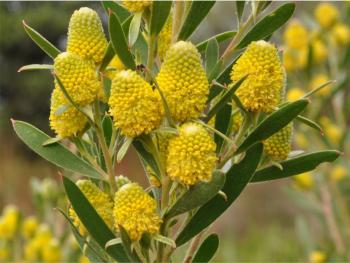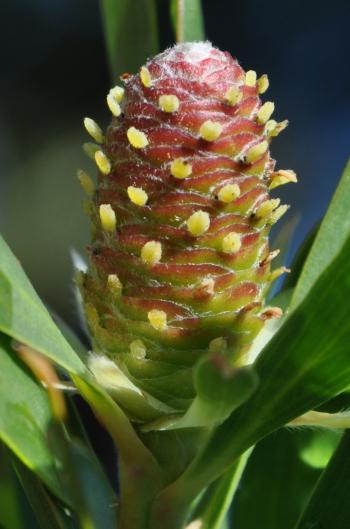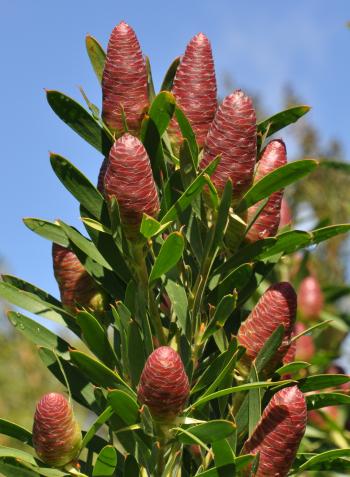Leucadendron macowanii
Leucadendron macowanii E.Phillips
Family: Proteaceae
Common names: acacia-leaf conebush, wattle-leaf conebush
Introduction
This is a fast-growing shrub with narrow, dark green leaves, bright yellow flower heads in profusion on the male plants in winter, and dark red cones on the female plants in winter to spring. It is an excellent plant for landscaping and looks best when planted in small groups of five to seven plants.

Description
Description
Leucadendron macowanii grows up to 2.3 m tall and has a single main stem. They are quite fast growing and should have attained a height of 2 m in three to four years from the date of sowing. The leaves are narrowly oblanceolate, thinly silky at the base, tipped with a fine recurved point. The leaves on female plants are generally longer than those on male plants.

The plants flower during winter (July and August), with the male plant looking the most attractive. The male flowerheads are made up of many tiny bright yellow flowers crowded together in small cone-like heads, about 14 mm in diameter and 15 mm long.

The female flowerhead is also cone-like, green turning red or reddish brown, 23 mm long. The female flowers can be seen as large yellow stigmas protruding from underneath the green or red scales of the ‘cone’. Neither the male nor the female have any scent.

The female cones enlarge as they ripen until they are 30 mm long and 25 mm in diameter. They are often a dark red or reddish brown, turning yellowish brown as they age and are held on the bush for a few years. The seeds are retained inside the cones till they are released by fire or by drying of the cones.
Conservation Status
Status
According to the Red List of South African plants, Leucadendron macowanii is Critically Endangered (CR). It is a rare species with a small natural range, and it is endemic to the Cape Peninsula. One small subpopulation remains, the only other known subpopulation is now extinct due to urban expansion. The wild population is known to fluctuate in response to fire, or lack of fire. This species is at risk from inappropriate fire management, expansion of vineyards and invasive alien plants, in particular Australian acacias or wattles. These alien trees not only suppress the growth of the remaining plants, but the wattle leaves look similar to those of Leucadendron macowanii and some plants have been mistakenly killed during clearing (alien hacking) operations.
Attempts are being made to introduce more subpopulations on the Cape Peninsula (e.g. at Tokai) and near Hermanus.

Distribution and habitat
Distribution description
This is now a very rare species, due to displacement by agriculture and urban development. It has completely disappeared from the Wynberg area and only occurs in a valley near the Cape Point Nature Reserve. It grows in damp sands near streams and is largely confined to wetland areas in Peninsula Sandstone Fynbos, but in the past it also occurred in Peninsula Granite Fynbos.
Derivation of name and historical aspects
History
Leucadendron macowanii was named after one of the first professors of botany in Cape Town, Professor Peter MacOwan (1830-1909), who collected a specimen in the Wynberg area in the Western Cape around 1883.

Ecology
Ecology
Leucadendron macowanii occurs in fynbos, which is a fire-prone vegetation, where natural fires occur every ten to thirty years. This 'Mediterranean' type of vegetation grows in soils with very low amounts of nutrients. These nutrients are used up by the plants during their lifetime and need to be returned to the soil to provide the food for a new generation of plants. Leucadendron macowanii is adapted to survive the fires by producing seeds throughout its lifetime, some of the seeds being distributed and stored in the soil, others being stored in the old cones on the plant, which will only be stimulated to open and release the seeds when the plant dies or is killed by fire. These natural fires occur mainly in late summer or autumn and are followed by the first winter rains, which provide the moisture the young seedlings need to grow to a size at which they can survive the long, hot summer.
The genus Leucadendron has the only 10 species in the Proteaceae family in southern Africa that are exclusively wind-pollinated and Leucadendron macowanii is one of these. The wind-pollinated species have two main characteristics: the flowers do not secrete nectar and they are odourless. The flowers of the female plants have large stigmas for filtering pollen out of the air. In the male plants, the pollen does not adhere to the pollen presenter as it does in most protea family plants, but when the flower opens and the wind is blowing it is scattered in large showers and drifts away in the wind (Rebelo 1995).
Uses
Use
The fresh red female cones are quite attractive on the plant and last well in flower arrangements.
Growing Leucadendron macowanii
Grow
Leucadendron macowanii is an easy shrub to grow in a normal garden situation where regular watering occurs. They prefer damp sands near streams and when planted in gardens do need regular watering to grow to their full potential. The soil should be well drained and the plants should be in full sun. They are best planted in small groups of five or seven plants, about 1.5 m apart, so that both male and female plants can be expected to be present. They are ideal for fynbos gardens.
Although the plants can be propagated vegetatively by making cuttings, the propagation is best done by seed, sown from the middle of March (late summer), when the day temperature starts to drop. The seed is sown in open seedbeds, in a light, well-drained soil and covered with a layer of sand (about 1 cm or 1 1/2 times the size of the seed). The bed is then covered with a grid to protect it against attacks from birds and rodents. The seed will germinate three to four weeks after sowing.
The plants can be damaged by leaf borers, but generally look healthy and do not suffer from many disfiguring diseases. Like all other Proteaceae, the most harmful and destructive diseases are fungal. Most losses occur during the summer months when a virulent root fungus (Phytophthora camphora) can attack the plants. Control through the use of fungicides in the garden is difficult and expensive. By the time the plant shows distress, it is normally too late to arrest the problem. The best methods of control are cultural, i.e. water plants early in the morning; keep soil surface cool by mulching; leave the soil as undisturbed as possible, i.e. do not hoe the soil around the plants; remove diseased plants immediately; do not over-water in summer and prune and remove diseased material.
Credits
H.G. Jamieson
Kirstenbosch National Botanical Garden
September 2002
updated by Alice Notten, August 2017
Plant Attributes:
Plant Type: Shrub
SA Distribution: Western Cape
Soil type: Sandy, Loam
Flowering season: Spring, Late Summer, Winter
PH: Acid, Neutral
Flower colour: Red, Yellow
Aspect: Full Sun
Gardening skill: Average
Special Features:
Horticultural zones







Rate this article
Article well written and informative
Rate this plant
Is this an interesting plant?
Login to add your Comment
Back to topNot registered yet? Click here to register.